Abstract
Cells of the coronary sinus of the canine heart can exhibit triggered activity which each action potential arises from a depolarizing after-potential that follows the previous action potential; an early after-hyperpolarization commonly precedes the delayed after-depolarization and both are increased in amplitude by the addition of noradrenaline. The delayed after-depolarization is thought to be caused by an inward current activated by a rise in intracellular Ca2+ that is, in turn, caused by Ca2+-induced release of Ca2+ from the sarcoplasmic reticulum (s.r.). The effects of caffeine and of ryanodine on the electrical activity of the coronary sinus were investigated because each of those agents is thought to affect the handling of intracellular Ca2+ by the s.r. The steady-state effect of exposure to 5 mM-caffeine is to cause the delayed after-depolarization to move much earlier in the cycle, and become too small to give rise to an action potential so that preparations cannot show triggered activity; moreover, if a burst of activity is in progress it is terminated by exposure to 5 mM-caffeine. Exposure to 0.5 mM-caffeine causes the delayed after-depolarization to move earlier in the cycle but to become larger so that triggered activity is more easily induced and longer lasting than in the absence of caffeine. Shortly after the addition (or wash-out) of 5 mM-caffeine the after-depolarization transiently resembles that seen in the presence of 0.5 mM-caffeine so that bursts of triggered activity may occur just after the addition or removal of 5 mM-caffeine. Exposure to 5 mM-caffeine abolishes early rapid repolarization (phase 1), shifts the plateau to a more positive level and retards the completion of repolarization. The effect on phase 1 is mimicked by exposure to solutions low in Cl-; the effect on the plateau is mimicked by exposure to 20 mM-tetraethylammonium (TEA); fibres exposed to solutions containing 20 mM-TEA and 21 mM-Cl- show action potentials very like those of fibres exposed to 5 mM-caffeine. If a fibre already exposed to a low Cl-, TEA-containing solution is then exposed to 5 mM-caffeine, no further change occurs in the action potential but the characteristic effects of caffeine on the after-depolarization appear. Exposure to ryanodine prevents the appearance of the delayed after-depolarization but leads to the appearance of an exceptionally long depolarizing after-potential that begins very early in diastole and, though waning, persists almost throughout diastole.(ABSTRACT TRUNCATED AT 400 WORDS)
Full text
PDF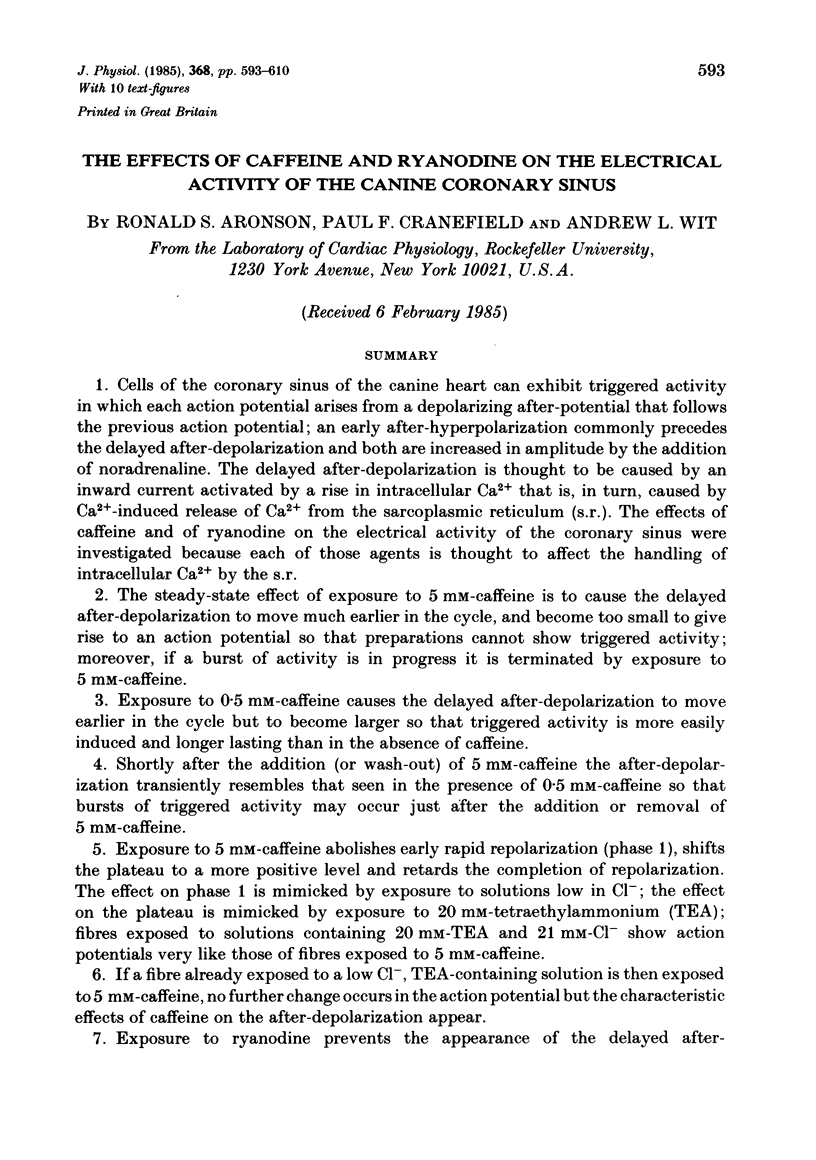
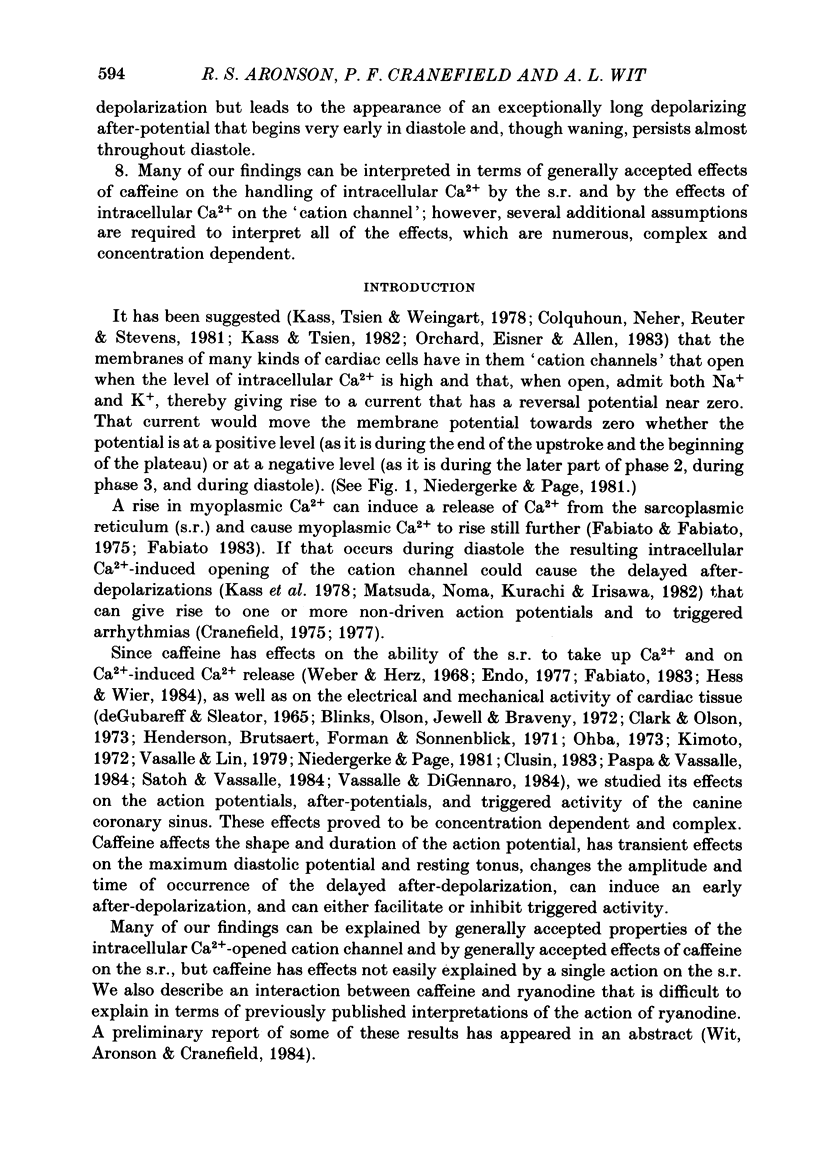
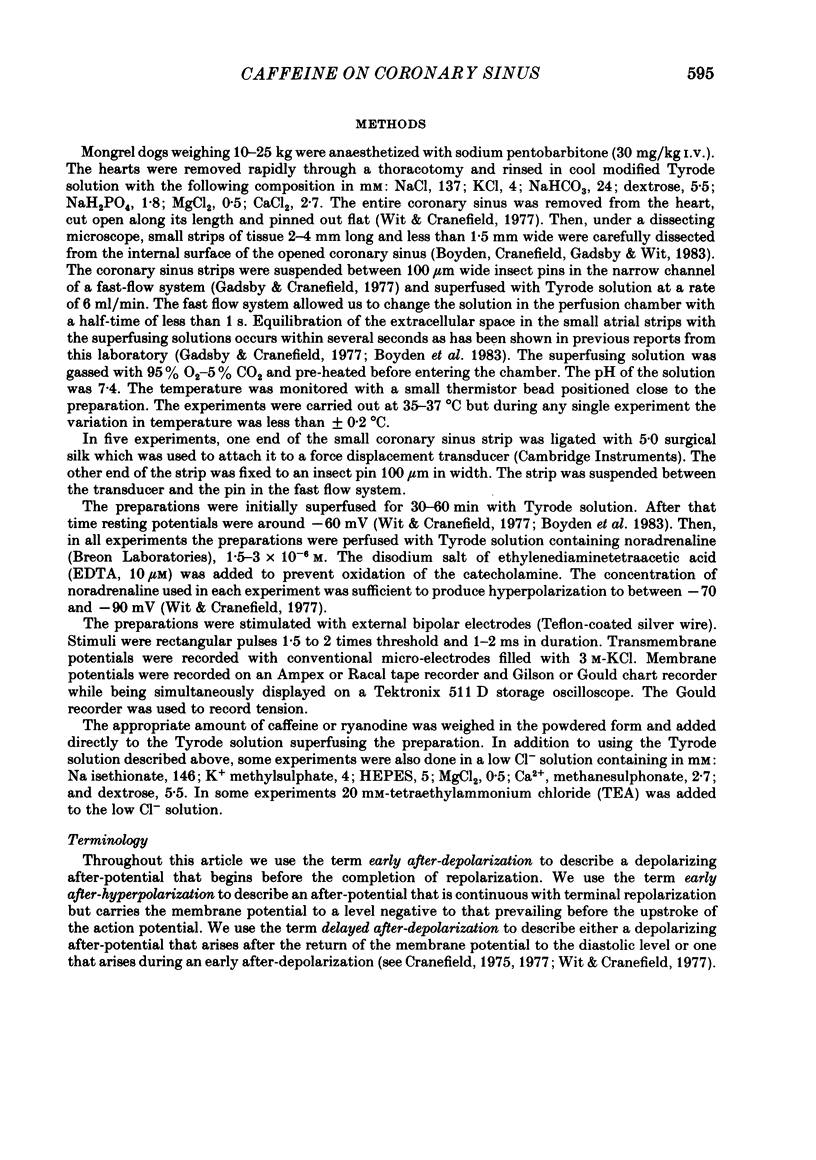
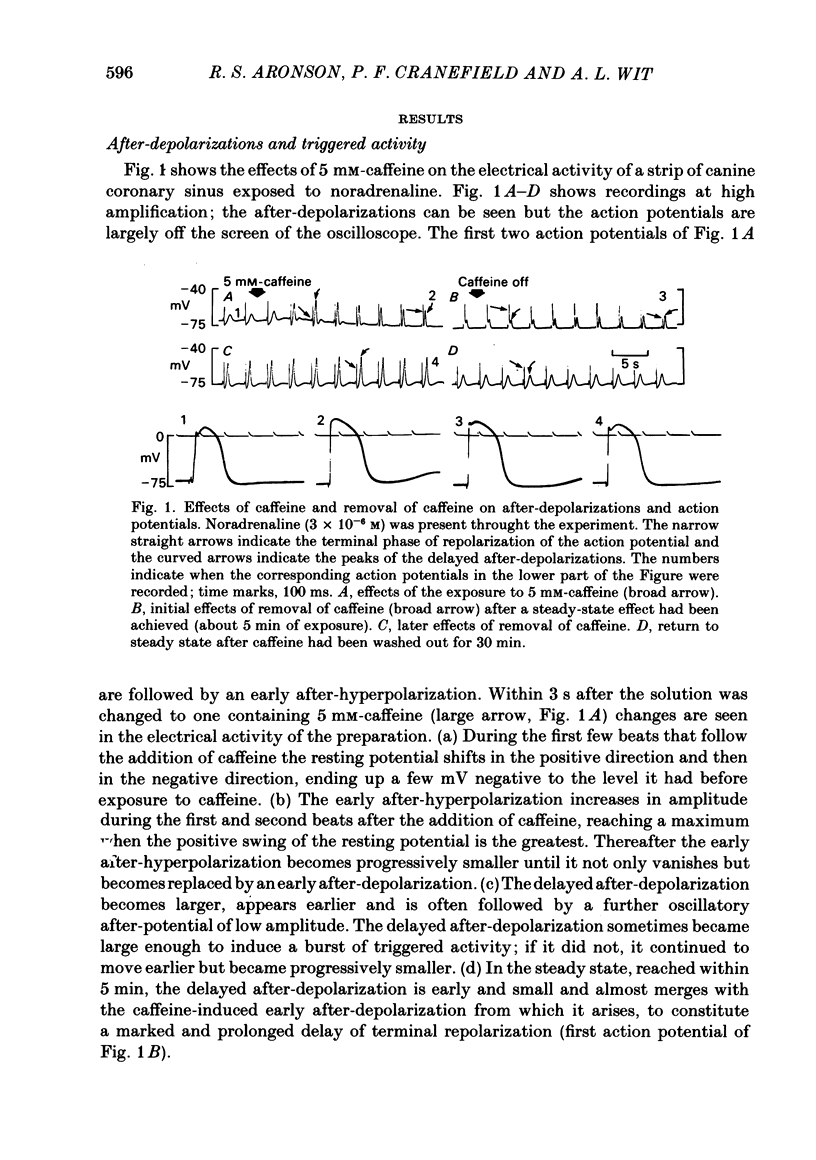
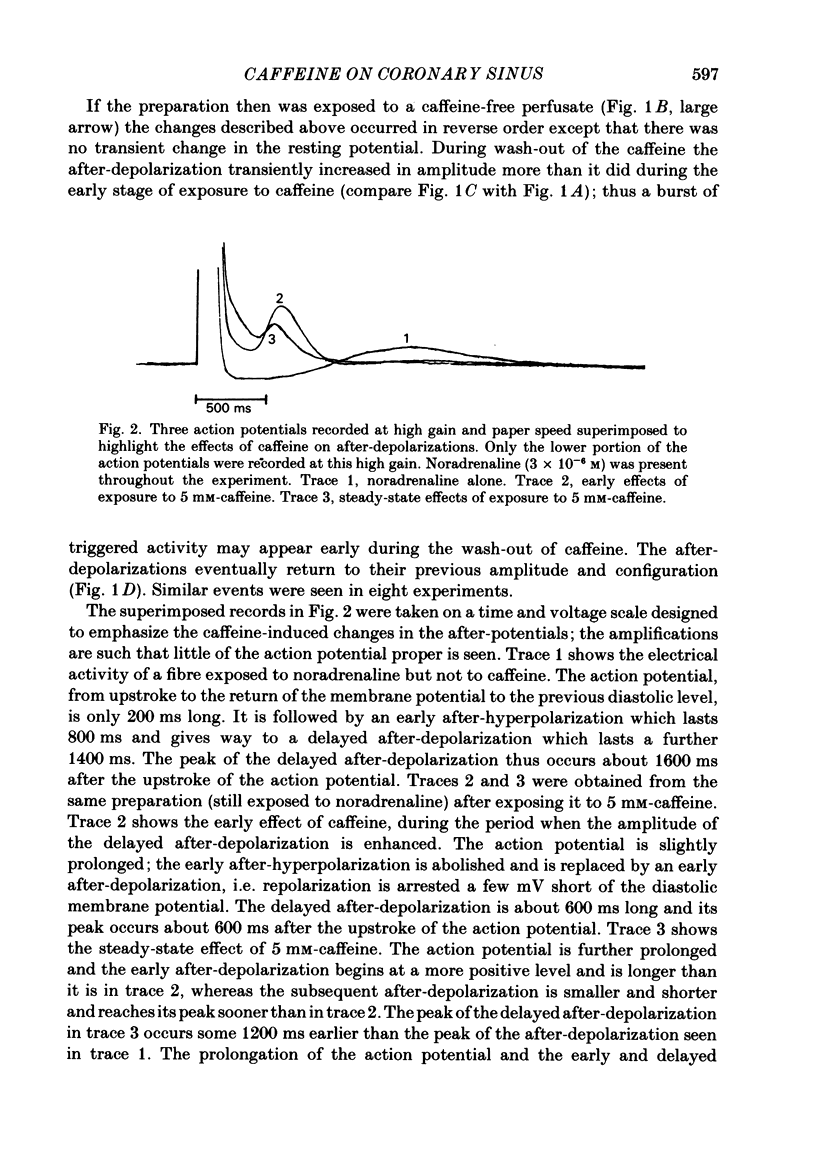
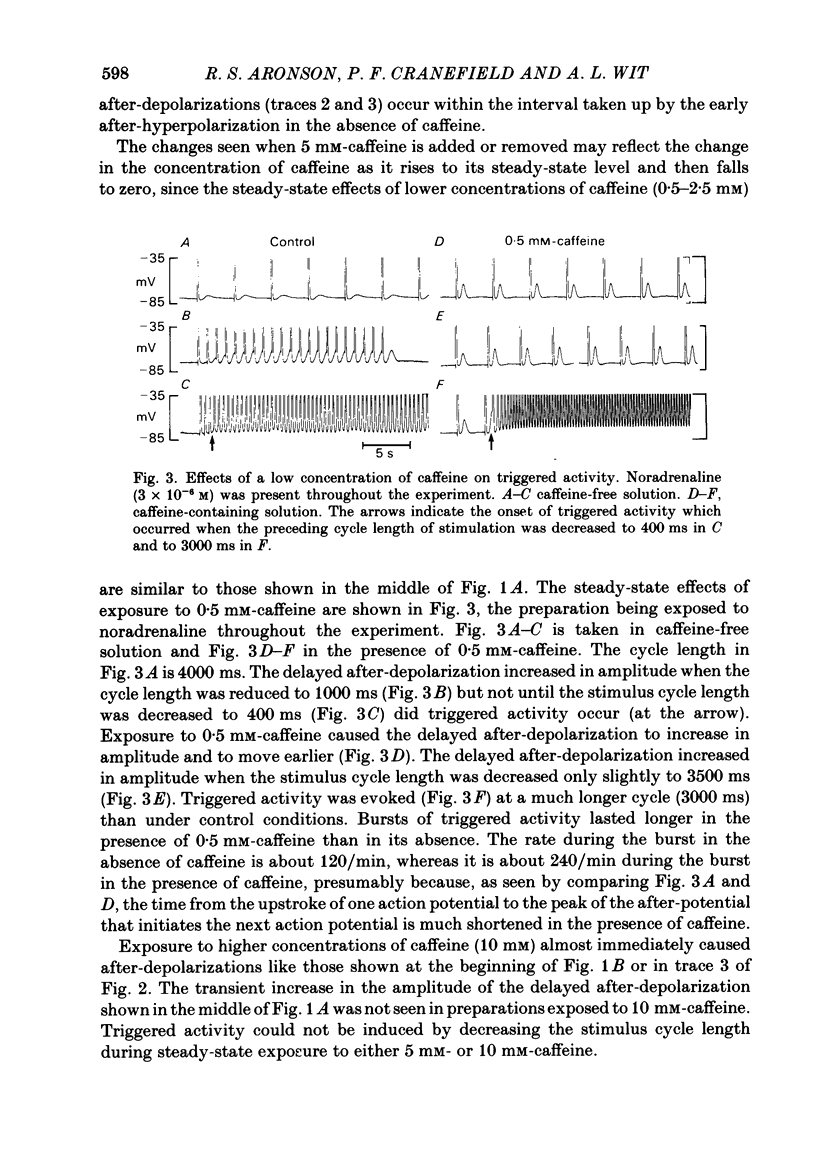
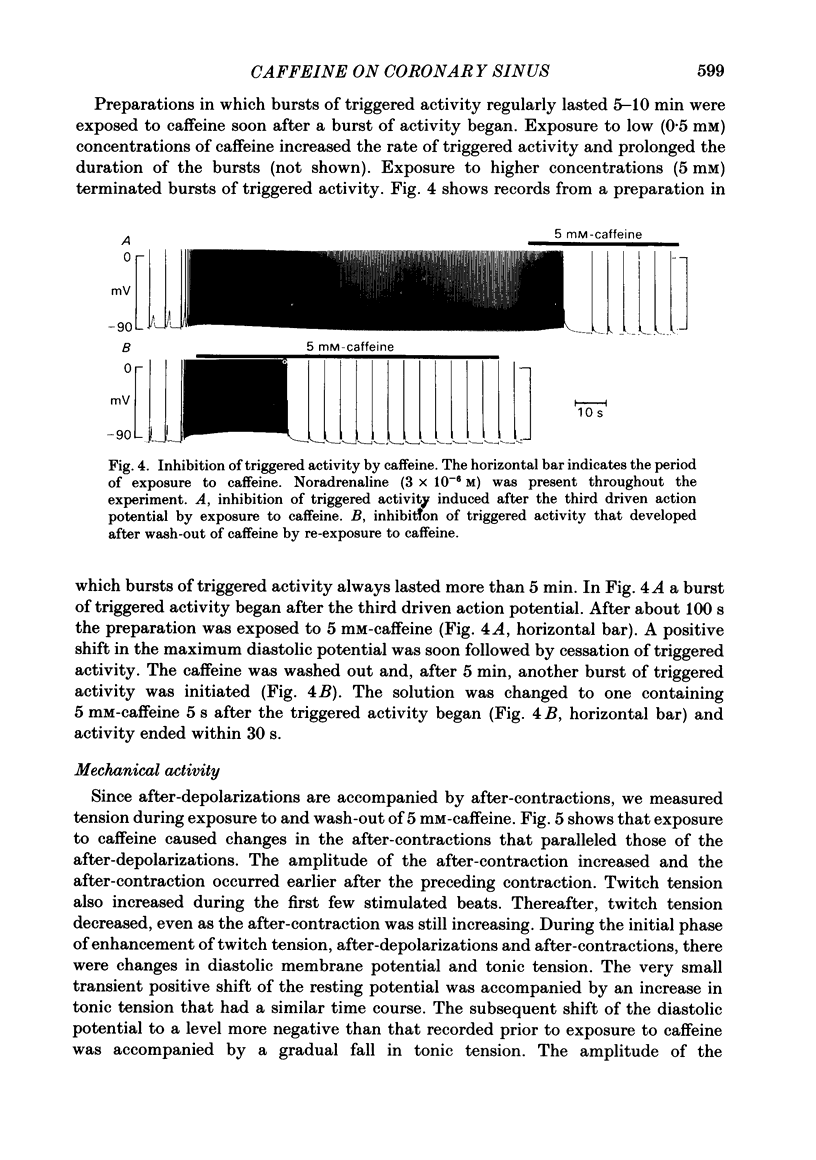
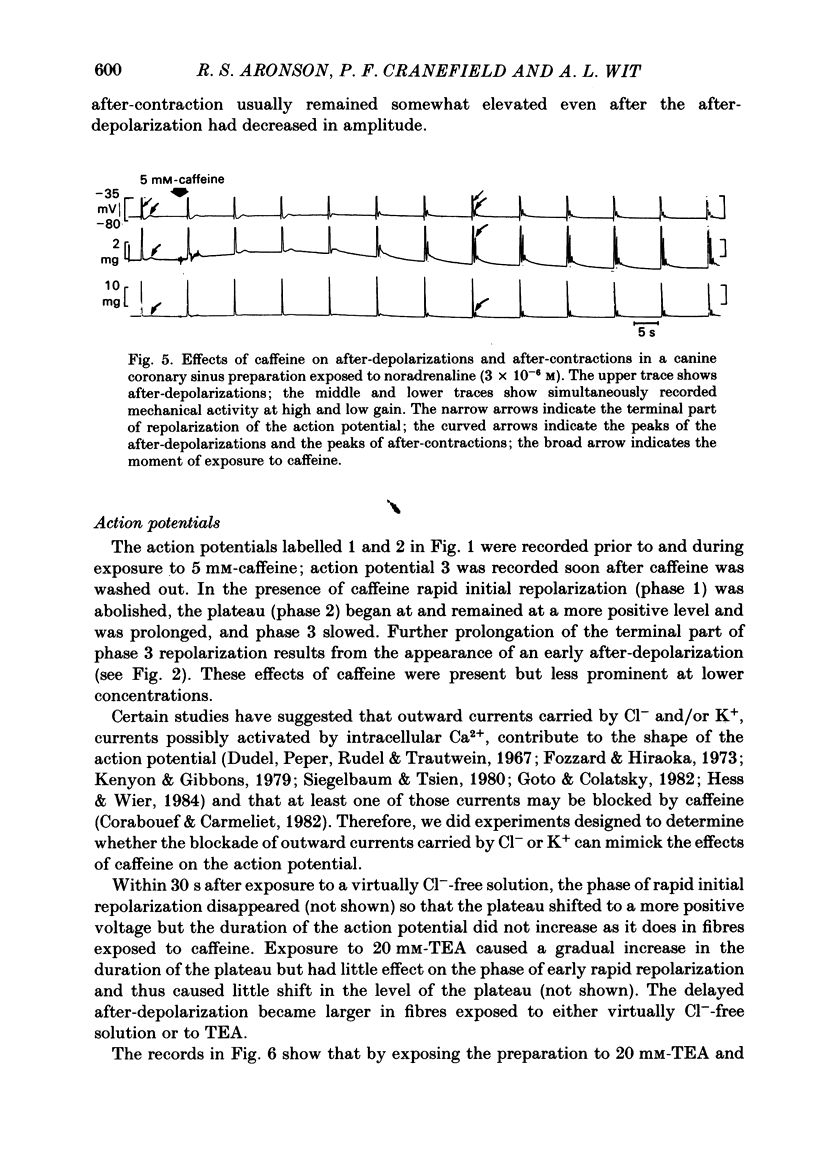
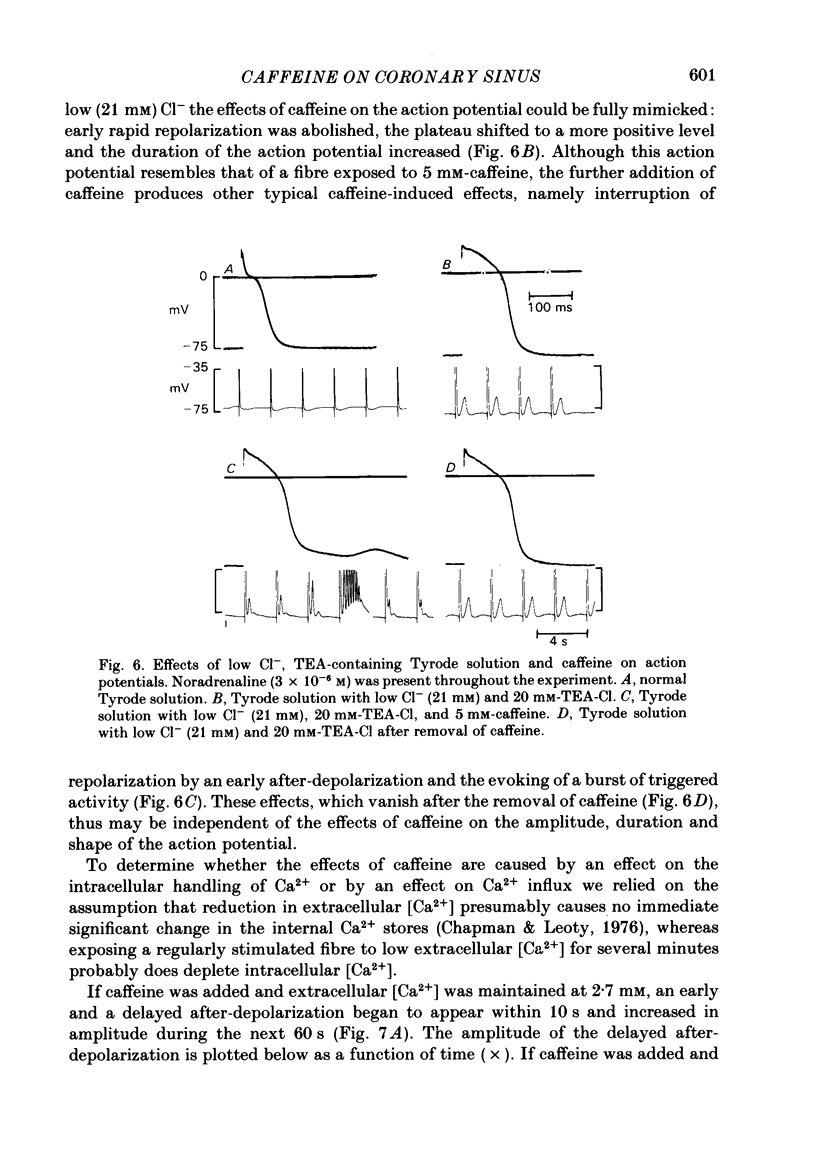
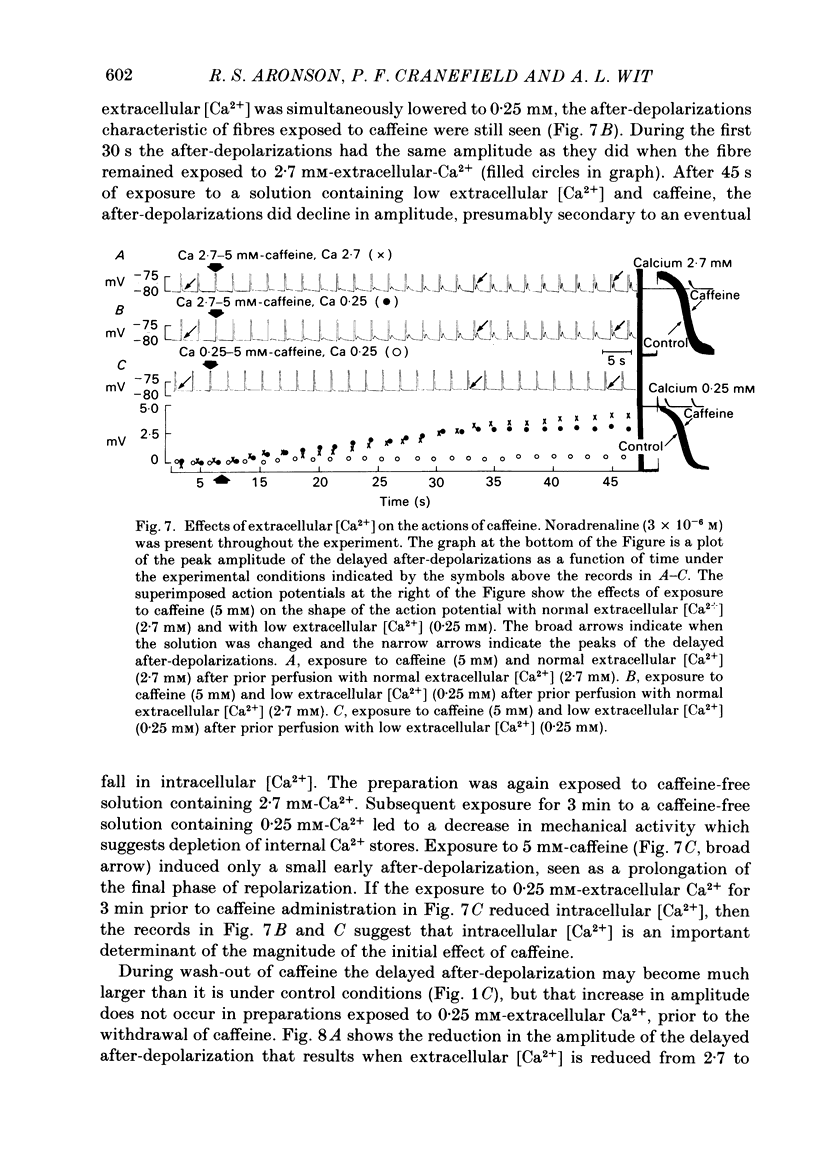
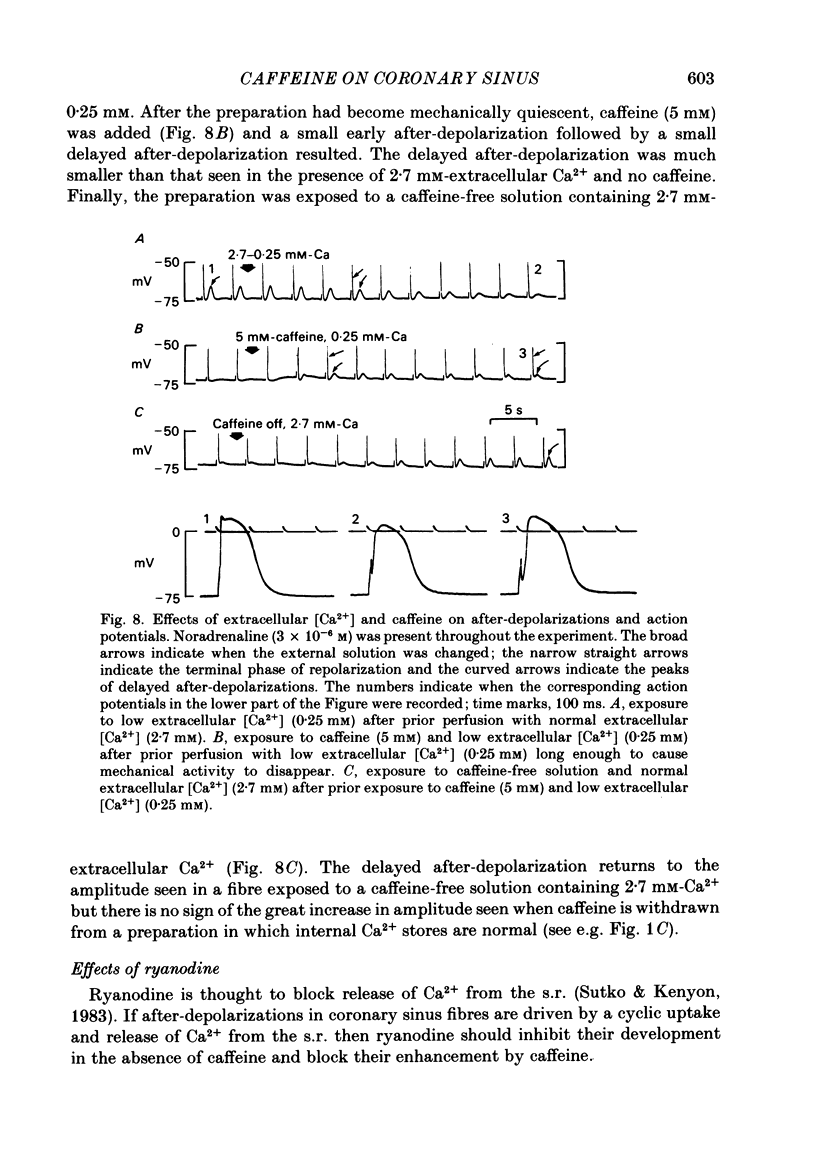
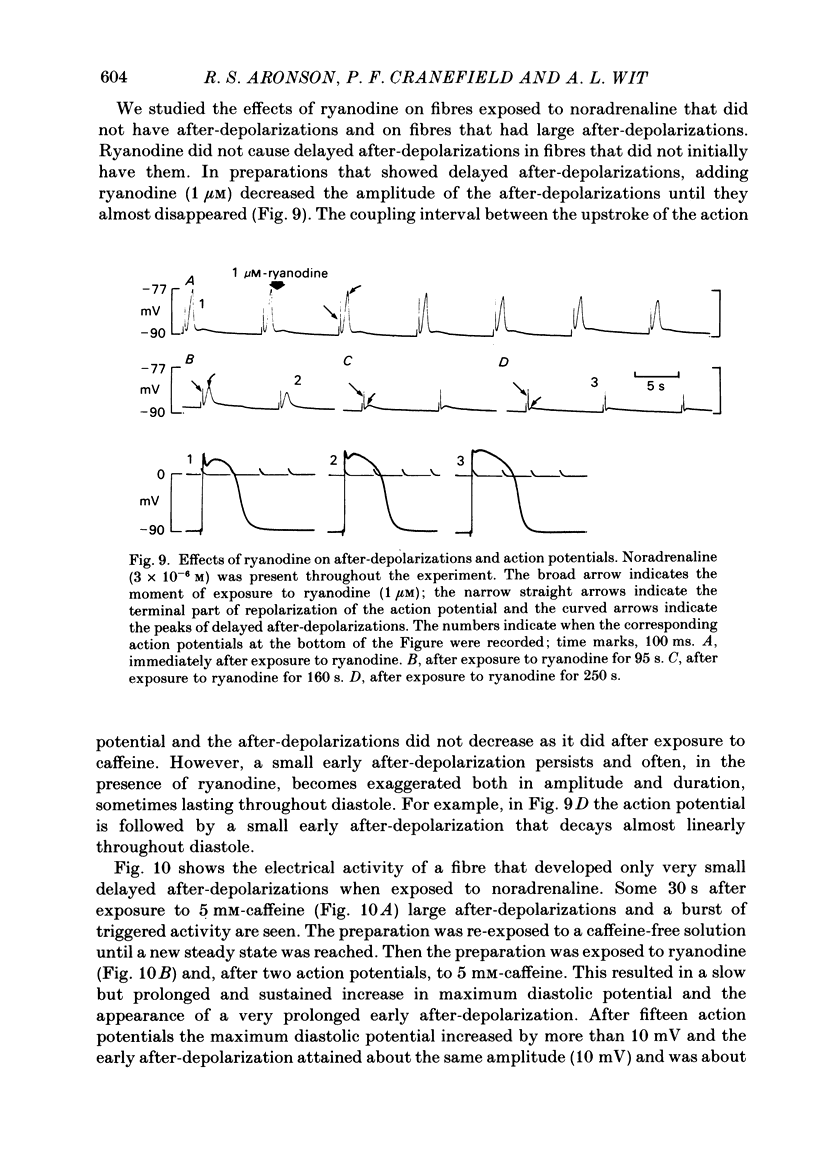

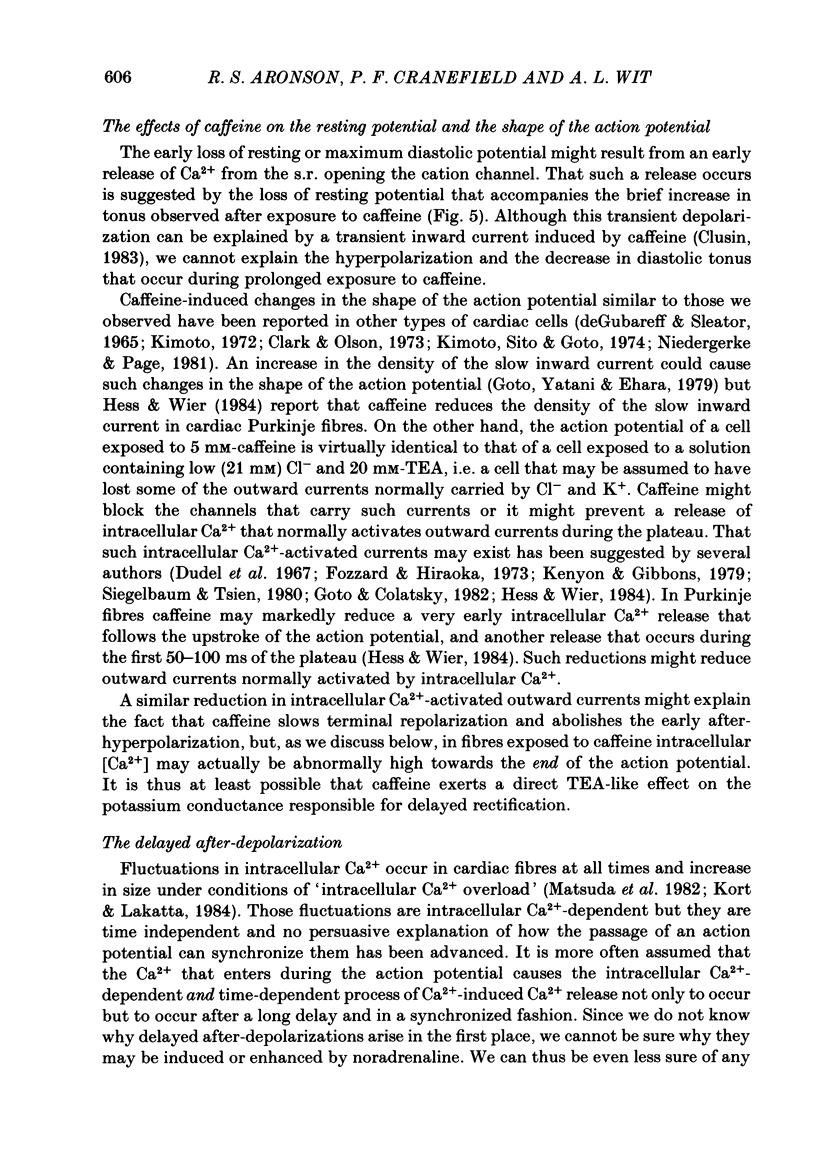
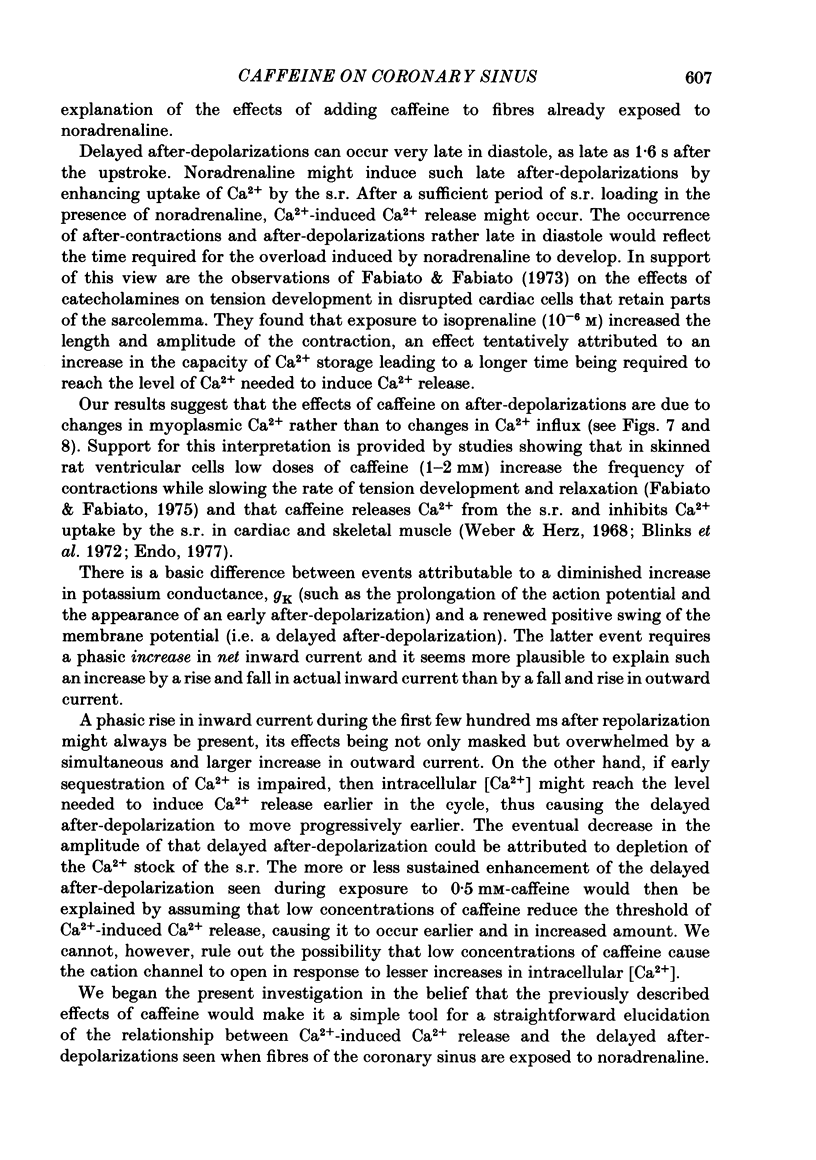
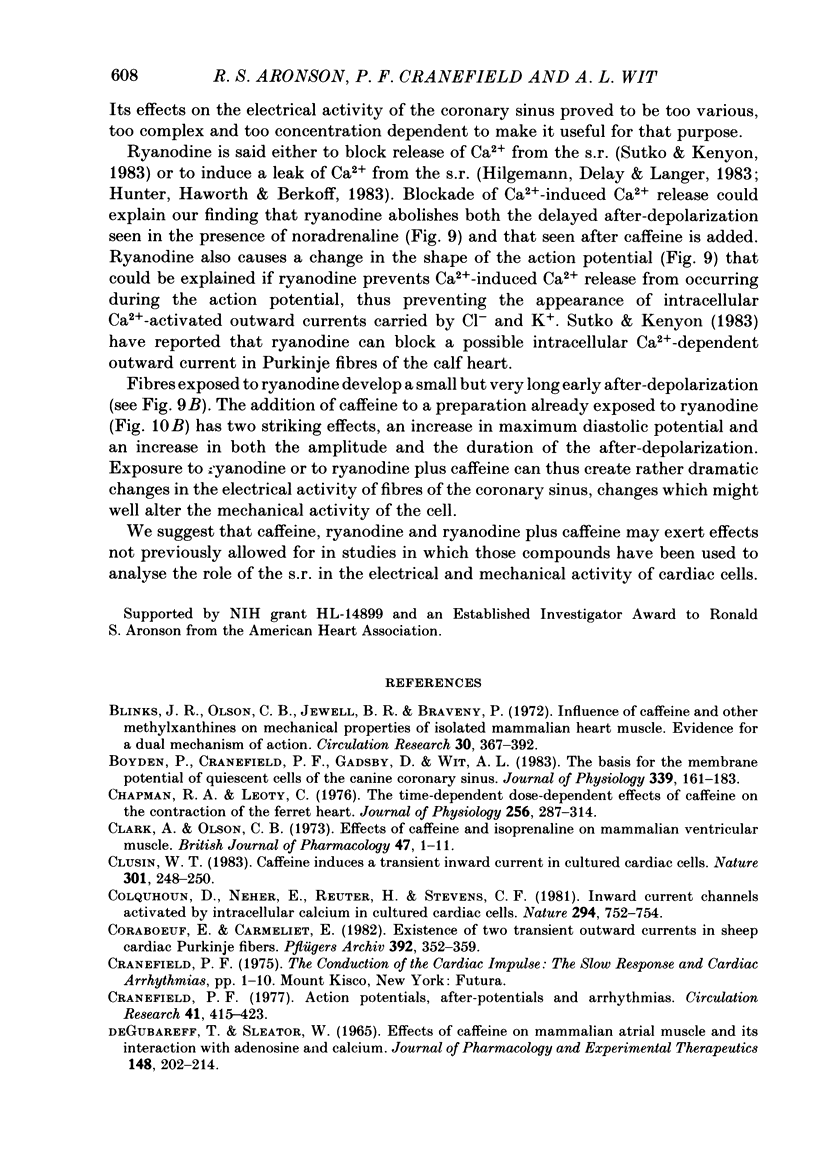
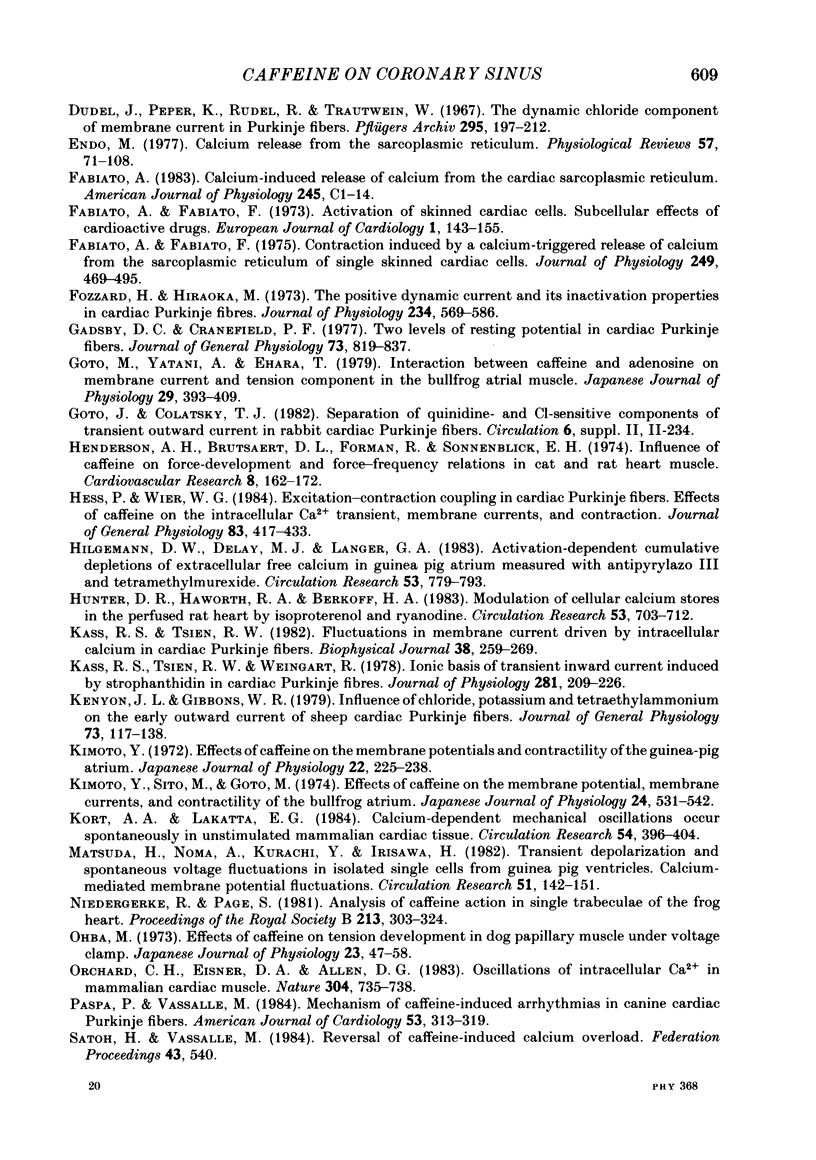
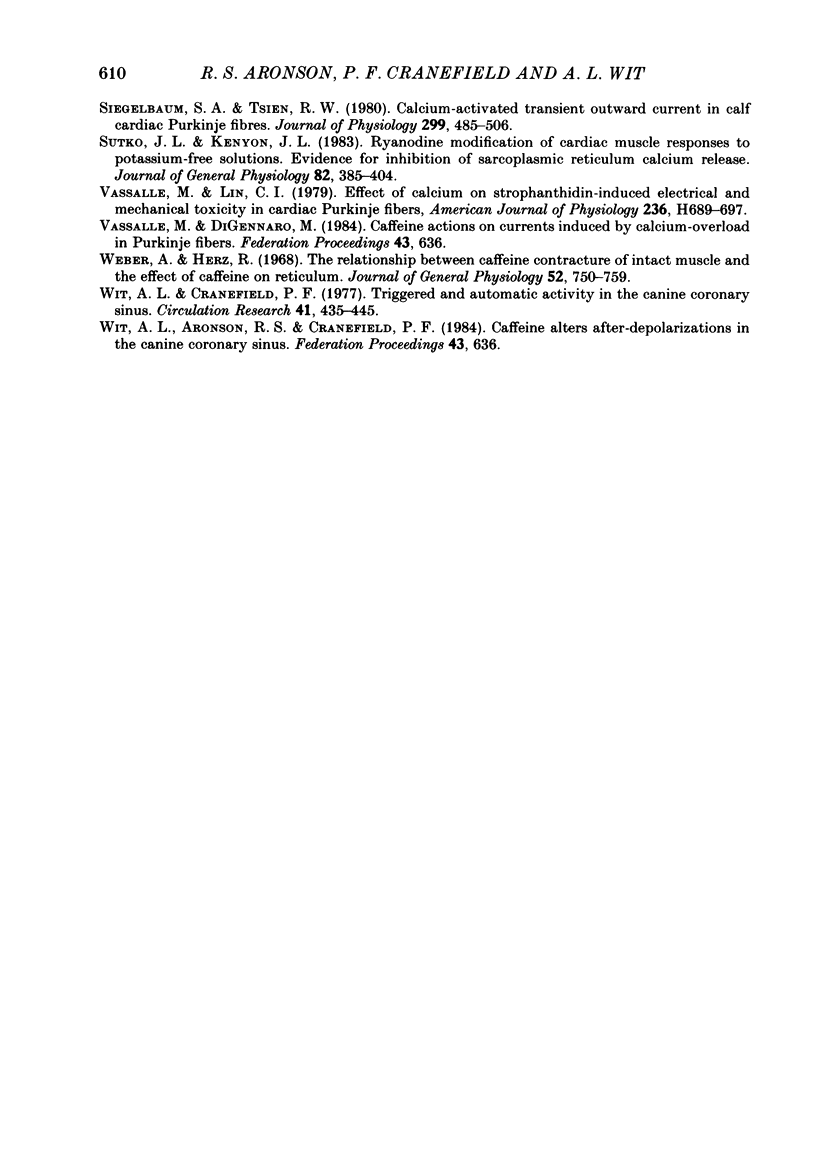
Selected References
These references are in PubMed. This may not be the complete list of references from this article.
- Blinks J. R., Olson C. B., Jewell B. R., Bravený P. Influence of caffeine and other methylxanthines on mechanical properties of isolated mammalian heart muscle. Evidence for a dual mechanism of action. Circ Res. 1972 Apr;30(4):367–392. doi: 10.1161/01.res.30.4.367. [DOI] [PubMed] [Google Scholar]
- Boyden P. A., Cranefield P. F., Gadsby D. C., Wit A. L. The basis for the membrane potential of quiescent cells of the canine coronary sinus. J Physiol. 1983 Jun;339:161–183. doi: 10.1113/jphysiol.1983.sp014710. [DOI] [PMC free article] [PubMed] [Google Scholar]
- Chapman R. A., Léoty C. The time-dependent and dose-dependent effects of caffeine on the contraction of the ferret heart. J Physiol. 1976 Apr;256(2):287–314. doi: 10.1113/jphysiol.1976.sp011326. [DOI] [PMC free article] [PubMed] [Google Scholar]
- Clark A., Olson C. B. Effects of caffeine and isoprenaline on mammalian ventricular muscle. Br J Pharmacol. 1973 Jan;47(1):1–11. doi: 10.1111/j.1476-5381.1973.tb08153.x. [DOI] [PMC free article] [PubMed] [Google Scholar]
- Clusin W. T. Caffeine induces a transient inward current in cultured cardiac cells. Nature. 1983 Jan 20;301(5897):248–250. doi: 10.1038/301248a0. [DOI] [PubMed] [Google Scholar]
- Colquhoun D., Neher E., Reuter H., Stevens C. F. Inward current channels activated by intracellular Ca in cultured cardiac cells. Nature. 1981 Dec 24;294(5843):752–754. doi: 10.1038/294752a0. [DOI] [PubMed] [Google Scholar]
- Coraboeuf E., Carmeliet E. Existence of two transient outward currents in sheep cardiac Purkinje fibers. Pflugers Arch. 1982 Feb;392(4):352–359. doi: 10.1007/BF00581631. [DOI] [PubMed] [Google Scholar]
- Cranefield P. F. Action potentials, afterpotentials, and arrhythmias. Circ Res. 1977 Oct;41(4):415–423. doi: 10.1161/01.res.41.4.415. [DOI] [PubMed] [Google Scholar]
- DEGUBAREFF T., SLEATOR W., Jr EFFECTS OF CAFFEINE ON MAMMALIAN ATRIAL MUSCLE, AND ITS INTERACTION WITH ADENOSINE AND CALCIUM. J Pharmacol Exp Ther. 1965 May;148:202–214. [PubMed] [Google Scholar]
- Dudel J., Peper K., Rüdel R., Trautwein W. The dynamic chloride component of membrane current in Purkinje fibers. Pflugers Arch Gesamte Physiol Menschen Tiere. 1967;295(3):197–212. doi: 10.1007/BF01844100. [DOI] [PubMed] [Google Scholar]
- Endo M. Calcium release from the sarcoplasmic reticulum. Physiol Rev. 1977 Jan;57(1):71–108. doi: 10.1152/physrev.1977.57.1.71. [DOI] [PubMed] [Google Scholar]
- Fabiato A. Calcium-induced release of calcium from the cardiac sarcoplasmic reticulum. Am J Physiol. 1983 Jul;245(1):C1–14. doi: 10.1152/ajpcell.1983.245.1.C1. [DOI] [PubMed] [Google Scholar]
- Fabiato A., Fabiato F. Activation of skinned cardiac cells. Subcellular effects of cardioactive drugs. Eur J Cardiol. 1973 Dec;1(2):143–155. [PubMed] [Google Scholar]
- Fabiato A., Fabiato F. Contractions induced by a calcium-triggered release of calcium from the sarcoplasmic reticulum of single skinned cardiac cells. J Physiol. 1975 Aug;249(3):469–495. doi: 10.1113/jphysiol.1975.sp011026. [DOI] [PMC free article] [PubMed] [Google Scholar]
- Fozzard H. A., Hiraoka M. The positive dynamic current and its inactivation properties in cardiac Purkinje fibres. J Physiol. 1973 Nov;234(3):569–586. doi: 10.1113/jphysiol.1973.sp010361. [DOI] [PMC free article] [PubMed] [Google Scholar]
- Gadsby D. C., Cranefield P. F. Electrogenic sodium extrusion in cardiac Purkinje fibers. J Gen Physiol. 1979 Jun;73(6):819–837. doi: 10.1085/jgp.73.6.819. [DOI] [PMC free article] [PubMed] [Google Scholar]
- Goto M., Yatani A., Ehara T. Interaction between caffeine and adenosine on the membrane current and tension component in the bullfrog atrial muscle. Jpn J Physiol. 1979;29(4):393–409. doi: 10.2170/jjphysiol.29.393. [DOI] [PubMed] [Google Scholar]
- Henderson A. H., Brutsaert D. L., Forman R., Sonnenblick E. H. Influence of caffeine on force development and force-frequency relations in cat and rat heart muscle. Cardiovasc Res. 1974 Mar;8(2):162–172. doi: 10.1093/cvr/8.2.162. [DOI] [PubMed] [Google Scholar]
- Hess P., Wier W. G. Excitation-contraction coupling in cardiac Purkinje fibers. Effects of caffeine on the intracellular [Ca2+] transient, membrane currents, and contraction. J Gen Physiol. 1984 Mar;83(3):417–433. doi: 10.1085/jgp.83.3.417. [DOI] [PMC free article] [PubMed] [Google Scholar]
- Hilgemann D. W., Delay M. J., Langer G. A. Activation-dependent cumulative depletions of extracellular free calcium in guinea pig atrium measured with antipyrylazo III and tetramethylmurexide. Circ Res. 1983 Dec;53(6):779–793. doi: 10.1161/01.res.53.6.779. [DOI] [PubMed] [Google Scholar]
- Hunter D. R., Haworth R. A., Berkoff H. A. Modulation of cellular calcium stores in the perfused rat heart by isoproterenol and ryanodine. Circ Res. 1983 Nov;53(5):703–712. doi: 10.1161/01.res.53.5.703. [DOI] [PubMed] [Google Scholar]
- Kass R. S., Tsien R. W. Fluctuations in membrane current driven by intracellular calcium in cardiac Purkinje fibers. Biophys J. 1982 Jun;38(3):259–269. doi: 10.1016/S0006-3495(82)84557-8. [DOI] [PMC free article] [PubMed] [Google Scholar]
- Kass R. S., Tsien R. W., Weingart R. Ionic basis of transient inward current induced by strophanthidin in cardiac Purkinje fibres. J Physiol. 1978 Aug;281:209–226. doi: 10.1113/jphysiol.1978.sp012417. [DOI] [PMC free article] [PubMed] [Google Scholar]
- Kenyon J. L., Gibbons W. R. Influence of chloride, potassium, and tetraethylammonium on the early outward current of sheep cardiac Purkinje fibers. J Gen Physiol. 1979 Feb;73(2):117–138. doi: 10.1085/jgp.73.2.117. [DOI] [PMC free article] [PubMed] [Google Scholar]
- Kimoto Y. Effects of caffeine on the membrane potentials and contractility of the guinea pig atrium. Jpn J Physiol. 1972 Apr;22(2):225–238. doi: 10.2170/jjphysiol.22.225. [DOI] [PubMed] [Google Scholar]
- Kimoto Y., Saito M., Goto M. Effects of caffeine on the membrane potentials, membrane currents and contractility of the bullfrog atrium. Jpn J Physiol. 1974 Oct;24(5):531–542. doi: 10.2170/jjphysiol.24.531. [DOI] [PubMed] [Google Scholar]
- Kort A. A., Lakatta E. G. Calcium-dependent mechanical oscillations occur spontaneously in unstimulated mammalian cardiac tissues. Circ Res. 1984 Apr;54(4):396–404. doi: 10.1161/01.res.54.4.396. [DOI] [PubMed] [Google Scholar]
- Matsuda H., Noma A., Kurachi Y., Irisawa H. Transient depolarization and spontaneous voltage fluctuations in isolated single cells from guinea pig ventricles. Calcium-mediated membrane potential fluctuations. Circ Res. 1982 Aug;51(2):142–151. doi: 10.1161/01.res.51.2.142. [DOI] [PubMed] [Google Scholar]
- Niedergerke R., Page S. Analysis of caffeine action in single trabeculae of the frog heart. Proc R Soc Lond B Biol Sci. 1981 Nov 13;213(1192):303–324. doi: 10.1098/rspb.1981.0068. [DOI] [PubMed] [Google Scholar]
- Oba M. Effects of caffeine on tension development in dog papillary muscle under voltage clamp. Jpn J Physiol. 1973 Feb;23(1):47–58. [PubMed] [Google Scholar]
- Orchard C. H., Eisner D. A., Allen D. G. Oscillations of intracellular Ca2+ in mammalian cardiac muscle. Nature. 1983 Aug 25;304(5928):735–738. doi: 10.1038/304735a0. [DOI] [PubMed] [Google Scholar]
- Paspa P., Vassalle M. Mechanism of caffeine-induced arrhythmias in canine cardiac Purkinje fibers. Am J Cardiol. 1984 Jan 15;53(2):313–319. doi: 10.1016/0002-9149(84)90445-4. [DOI] [PubMed] [Google Scholar]
- Siegelbaum S. A., Tsien R. W. Calcium-activated transient outward current in calf cardiac Purkinje fibres. J Physiol. 1980 Feb;299:485–506. doi: 10.1113/jphysiol.1980.sp013138. [DOI] [PMC free article] [PubMed] [Google Scholar]
- Sutko J. L., Kenyon J. L. Ryanodine modification of cardiac muscle responses to potassium-free solutions. Evidence for inhibition of sarcoplasmic reticulum calcium release. J Gen Physiol. 1983 Sep;82(3):385–404. doi: 10.1085/jgp.82.3.385. [DOI] [PMC free article] [PubMed] [Google Scholar]
- Vassalle M., Lin C. I. Effect of calcium on strophanthidin-induced electrical and mechanical toxicity in cardiac Purkinje fibers. Am J Physiol. 1979 May;236(5):H689–H697. doi: 10.1152/ajpheart.1979.236.5.H689. [DOI] [PubMed] [Google Scholar]
- Weber A., Herz R. The relationship between caffeine contracture of intact muscle and the effect of caffeine on reticulum. J Gen Physiol. 1968 Nov;52(5):750–759. doi: 10.1085/jgp.52.5.750. [DOI] [PMC free article] [PubMed] [Google Scholar]
- Wit A. L., Cranefield P. F. Triggered and automatic activity in the canine coronary sinus. Circ Res. 1977 Oct;41(4):434–445. doi: 10.1161/01.res.41.4.434. [DOI] [PubMed] [Google Scholar]


